Podcast: Play in new window | Download (Duration: 30:52 — 28.4MB) | Embed
Subscribe: Apple Podcasts | Spotify | Amazon Music | Android | Pandora | iHeartRadio | JioSaavn | Podchaser | Gaana | Podcast Index | Email | TuneIn | Deezer | Anghami | RSS | More
Episode 44 – John 21 Part 2 –The Reinstatement of Peter

We conclude our amazing journey through the Gospel of John with chapter 21. Sharon begins her lecture with the question Jesus asks of Peter and of each of us: Do you love me? This particular chapter is packed with an abundance of symbolism and profound theological truths.
We can date the writing of John’s Gospel to a clue found in this chapter. The Sea of Galilee was known by a variety of other names, including the Sea of Chinnereth (meaning harp-shaped) and the Sea of Gennesaret. However, John calls it the Sea of Tiberius, indicating that John wrote his Gospel sometime after 20 A.D. when Herod Antipas built the city of Tiberius in honor of the reigning Roman emperor and also renames the lake in honor of Caesar Tiberius.
Having seen the risen Christ on two occasions, Peter and the other disciples decided to go fishing and encounter Jesus for the third time in John’s Gospel. John 21, the reinstatement of Peter, is best understood in relation to Luke 5, the call of Peter. In Luke 5, Peter has been fishing all night, catching nothing. Jesus invites Peter to put his nets out into the deep waters and he catches a great number of fish, causing his nets to tear. Peter is immediately aware of the power of Jesus as well as his own sinful nature and he leaves everything to follow Christ. In John 21, once again Peter has been fishing all night, catching nothing. Jesus appears on the shore, inviting him to cast out the right side of the boat. Once again, Peter catches a super-abundance of fish and jumps out of the boat to greet the Lord. This time, the nets do not tear, symbolizing the enduring nature of the Church, which will prevail against all threats. Jesus and the disciples share of a meal of five fish, symbolic of the Torah, and two fish, symbolic of the Jews and Gentiles, indicating that Jesus fulfills the covenant with Israel and establishes a new universal covenant for all.
Sharon then goes on to explore the meaning behind 153, the number of fish that are caught in this chapter. The church fathers have proposed a variety of explanations, including Augustine’s realization that 153 is the sum of the integers from 1 to 17. However, Sharon shows us an even more intriguing explanation. Pythagoras, who lived centuries before Jesus, described himself as the first philosopher, or literally “lover of wisdom.” Pythagoras was a great mathematician and discovered a number of still famous theorems. He discovered that only four numbers exist, whose sum of the cube of the digits equals that same number. The first of these numbers is 153: (13+ 53+ 33= 153). The symmetry of this number is a reminder of the beautiful symmetry of the desert tabernacle in Exodus, the Holy of Holies in Solomon’s temple in 1 Kings, and the heavenly tabernacle in Revelation.
Sharon concludes her lecture by drawing from Pope Benedict’s insights into the three-fold acquittal of Peter in Chapter 21, absolving him of his three-fold denial. Peter acknowledges the weakness of his human love for Jesus, realizing he does not yet have the perfect agape type of love that he so desires. However, Jesus welcomes whatever love Peter has to offer, and reinstates him as vicar, charging him and his successors to shepherd the flock of the Church.
Sharon Doran serves as the teaching director of “Seeking Truth.” An experienced Bible Study teacher, Sharon has a passion for scripture that will motivate and challenge you to immerse yourself in God’s Word and apply His message to your everyday life.
For more in this series, visit the Seeking Truth with Sharon Doran Discerning Hearts page.
 “Seeking Truth” is an in-depth Catholic Bible Study commissioned by the Archdiocese of Omaha in response to John Paul II’s call to the New Evangelization as well as Pope Benedict XVI’s exhortation for all Catholics to study scripture. To learn more, go to www.seekingtruth.net
“Seeking Truth” is an in-depth Catholic Bible Study commissioned by the Archdiocese of Omaha in response to John Paul II’s call to the New Evangelization as well as Pope Benedict XVI’s exhortation for all Catholics to study scripture. To learn more, go to www.seekingtruth.net

